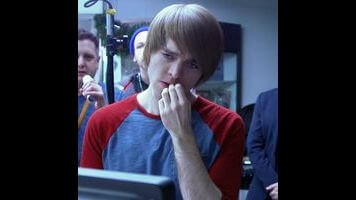At first glance, The Chair might look like self-plagiarizing on the part of Project Greenlight executive producer Chris Moore, but this take on a documentary series about first-time directors deserves a closer look. The Chair’s first two episodes do little to displace the notion that Moore is treading in familiar territory, but they’re reminders that it’s rich and compelling territory, at least when the production gets out of the way and lets the ups and downs of the contemporary film industry play out unimpeded. While burdened by some unnecessary trappings that manufacture conflict instead of highlighting it, The Chair documents a filmmaking experiment worth following.
The series’ endless stream of artsy talking heads—featuring Moore and fellow executive producer and mentor Zachary Quinto, among others—spend a lot of time laying out the premise of the series, which is ultimately simple: Two first-time filmmakers are given the same script and the same (low) budget, and are then let loose to make their version of the feature, competing for a $250,000 prize. Whereas Project Greenlight has historically focused on how a director’s vision is compromised by the logistics and pitfalls of independent filmmaking, The Chair takes that element and doubles it to consider how divergent directors confront those issues, and how the same material gets reframed through different lenses. It’s really two documentaries in one (the directors never interact with one another), with the editors switching between the two narratives to make a larger argument about the future of independent filmmaking.
It’s an engineered narrative: Rather than emerging from a nationwide selection process, filmmakers Shane Dawson and Anna Martemucci were hand-selected by Moore, as if he’s Don King promoting a boxing match for the future of cinema. Martemucci is a NYU-alum screenwriter who has worked with Quinto’s production company and wants to break into directing. Dawson is a YouTube star—recently profiled by Variety—seeking the legitimacy of feature work to expand his professional identity beyond short-form streaming video. The Chair positions them as polar opposites, with Martemucci’s indie credibility bumping up against Dawson’s millions of subscribers.
In truth, these identities are limited constructs: Martemucci dabbled in online shorts through the Periods. Films series, while NBC bought a a semi-autobiographical pilot pitch from Dawson in 2013. They may have different sensibilities, but they’re pushing against the limits of media production and distribution in their own ways, which makes them each interesting case studies in their own right. Dawson’s navigation of his existing fan base within the filmmaking process offers tremendous insight into the challenges facing YouTube creators moving away from the safety of their channels, while Martemucci’s articulation of gender in the context of filmmaking reveals another way her story expands beyond the frame—“New York independent scene”—The Chair sticks her in.
Martemucci and Dawson are also joined by a dynamic cast of supporting characters. Screenwriter Dan Schoffer—whose generic coming-of-age script is being adapted into Martemucci’s Hollidaysburg and Dawson’s Not Cool—plays an interesting role, bouncing between the two productions and watching as the directors dramatically change the context of his story. Moore himself shows up on occasion, running between donor appointments in an effort to drum up production funding. (Some of which comes from an organization devoted to making Pittsburgh a go-to destination for film and TV production—hence the talking heads from the producers/filmmakers touting the city’s ability to double for other, more popular shooting locations.) But it’s Dawson’s producing partner, Lauren Schnipper, who turns out to be the series’ surprise star. With a no-nonsense attitude toward the production and a sisterly familiarity with the Internet star, Schnipper bridges the traditional and digital worlds.
Once these characters emerge, and once Dawson and Martemucci’s narratives are filled in by some cursory Googling (as opposed to the stock narratives offered by the series), The Chair becomes a rich intersection of emerging media forms, traditional media practices, and questions of professional and personal identity. The problem is that The Chair isn’t being sold as that show. The best moments in the early episodes often feel like sidebars to the “show” itself, distractions amid the so-called competition between these two filmmakers. The decision to push The Chair as a competition is confounding, because despite the test-screening-like surveys designed for the competition, any form of online voting will privilege Dawson’s rabid fan base, and because there is no need for this to be a competition.
Why does there need to be a winner for this competition to be meaningful? Why does there need to be a cash prize as incentive when there’s enough incentive in merely having final cut on a feature-length debut made with someone else’s money? (Regardless of the entire process being put in front of documentary cameras.) Why isn’t there enough payoff in the divergence of the two projects—Martemucci’s romantic dramedy versus Dawson’s raunchy teen sex comedy—and the details gleaned from the process? Moore has argued that the money adds drama and reward for the filmmakers, but the show is at its best when the cash prize is ignored and the filmmaking is left to speak for itself.
The Chair has lots to show us about the changing face of independent media production, but it’s not confident enough in that material’s appeal to let it stand on its own. The series pushes a narrative that makes for catchy ad copy—“1 script, 2 visions, 1 winner”—but it’s too contrived to find the truth of the changing industry it seeks to disrupt.









































